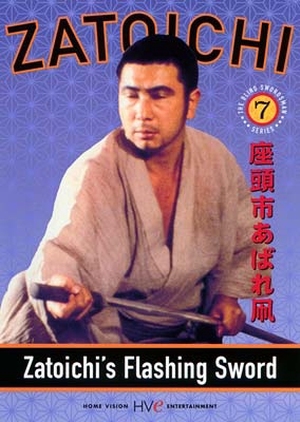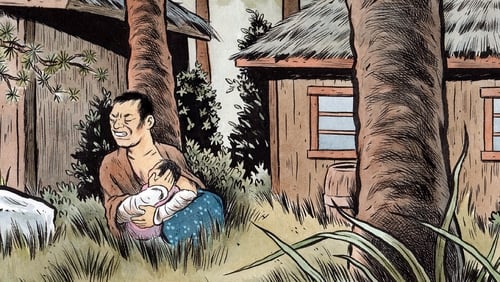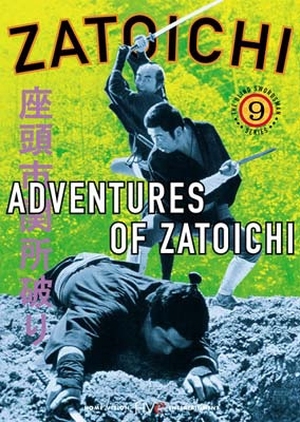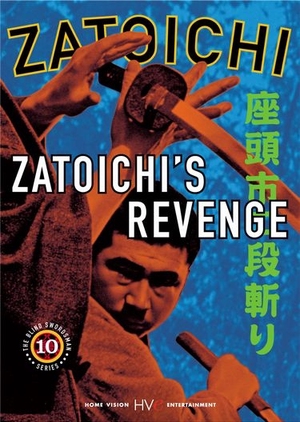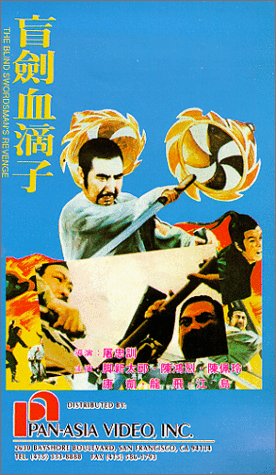Zatoichi - Films 6 - 10
Zatoichi and the Chest of Gold (1964)
- 8.0
Dir: Kazuo Ikehiro
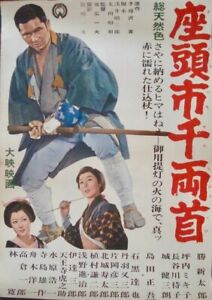
This sixth in the series is so far the
best as far as I am concerned. It is stylish, beautifully photographed and
has a narrative that has an emotional core. This was the director's first
Zatoichi film and he brings a real energy to it and ups the death count but
still retains many of the series' s trademarks. He was to make a few more
as well as some of the films in the Sleepy Eyes of Death series. The final
encounter is astonishing in the physicality that Shintaro Katsu goes through.
And once again Katsu's real life brother Tomisaburo Wakayama is the brute
villain.
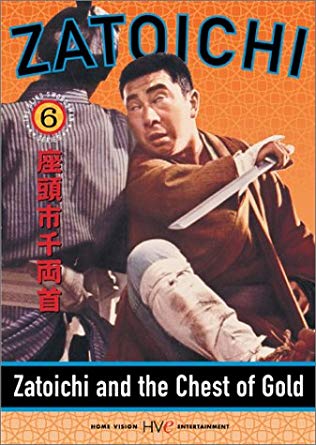
Zatoichi is in a solemn mood. He has come
to a small village graveyard to pray for a man who he killed two years ago
in an incident of confusion and misunderstanding. It turns into a complicated
plot when Zatoichi finds himself sitting on a chest of gold that was raised
by the villagers to pay their taxes. Their caravan had been attacked by thieves
and the chest rolled down a hill to where Zatoichi was resting. Later he
is accused of stealing the chest and other narratives enter into the story
that lead to a great conclusion.
Zatoichi’s Flashing Sword (1964) – 8.0
Dir: Kazuo Ikehiro
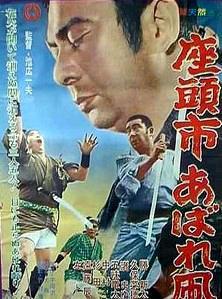
This is a stunning Zatoichi film - the
7th in the series. The photography is gorgeous, the action set pieces are
imaginative and well done and it has a terrific story that underlies it all.
The story unfolds slowly - really no action to speak of till about the 50
minute mark and then all hell breaks loose with the final fight just dazzling.
Zatoichi gets wounded by a rifle but a
passing lady pays for him to get better. He tracks her down to thank her
and as usual falls into a gang rivalry - her father being the head of one.
Zatoichi has to take on some bounty hunters, a group of samurai out to stop
him and God knows how many in one of the gangs - it is a bloodletting of
beauty and sadness.
Fight, Zatoichi,
Fight (1964) – 7.5
Dir: Kenji Misumi
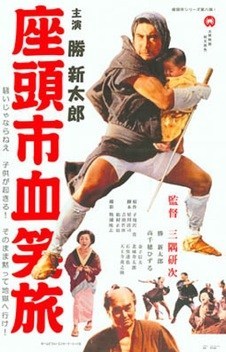
Six years before the Lone Wolf and Cub
manga and eight years before the series of films starring Tomisaburo Wakayama
that were produced by Shintaro Katsu is this little gem - the 8th in the
Zatoichi series. This may have sparked the idea for the Lone Wolf films.
Tomisaburo was also Katsu's real life brother.
In this one, a woman is mistaken for Zatoichi
in a covered carriage and killed protecting her baby. Zatoichi takes on the
responsibility of getting the baby to the father some 60 miles and what turns
out to be a long string of dead bodies away. Zatoichi as is often the case
has bounty hunters and other various gangs out for his head. He fights through
them with baby in his arms. The Zatoichi films continue to increase the body
count as they go along. This one has a tragic karma fatalism all around it
and ends with a note of poignant pessimism that floods through Zatoichi.
Everything he tried to fix ends up broken and destroyed.
The Adventures
of Zatoichi (1964) – 7/10
Dir: Kimiyoshi Yasuda
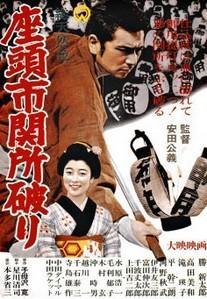
This is the ninth in the Zatoichi series
starring Shintaro Katsu as the blind masseuse/ swordsman extraordinaire.
It treads on the backs of all the films that came before it with elements
that they all share. One might think this would get too repetitive and tedious,
but at least so far not at all. You may know where a Zatoichi film is headed
but it is a great pleasure getting there in so many ways. In fact, the familiarity
of it is comforting.
The production values of these films are
topnotch with vivid colors and sets and costumes that recreate the period
wonderfully well. These small towns with their varied shops, inns and sake
bars all tended to by a myriad of extras feels so genuine that you feel transported
back a bit. The inevitability of Zatoichi coming to the aid of a pretty face
and then having to cut down the villains never feels stale. It builds up
slowly and then there is the bloodletting that every Zatoichi film has to
end with.
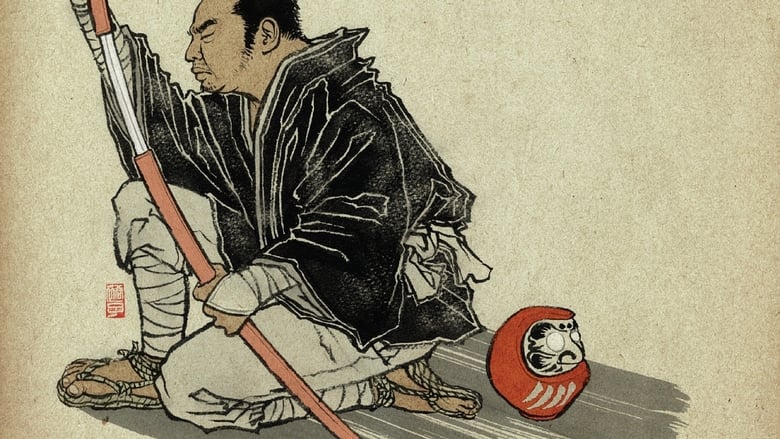
In this instance Zatoichi has come to a
small village below Mount Myogi. It is a few days before the New Year and
winter is setting in. Zatoichi wants to greet the New Year giving prayer
and thanks at the top of the mountain. But every town in Japan at the time
seems to have a Mr Big and his ruffians to run things and usually sooner
rather than later they come into conflict with Zatoichi as he always feels
the need to intervene when the weak are preyed on. Especially if it is a
young and lovely damsel (he can judge a woman's looks by her voice). Here
there are two women in trouble with the gang - one looking for her father;
the other trying to help her brother. It turns out his path to Mount Myogi
is littered with the bodies of the men he has to kill.
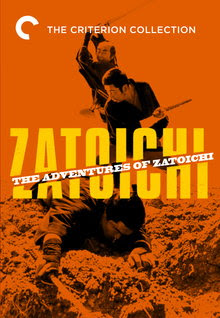
This is a terrific addition to the series
- letting the drama play out for about 50 minutes before Zatoichi has to
draw his sword and a few other plot lines that tag along are of interest
- a man who might be his long lost father and a young fast swordsman (Mikijiro
Hira) who wants to prove his mettle by drawing on a reluctant Zatoichi.
Zatoichi’s Revenge
(1965) – 7.5
Dir: Akira Inoue
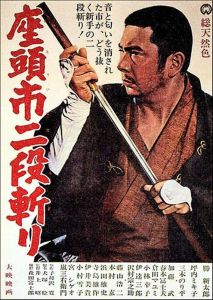
The killing takes its time to arrive in
the 10th film in the Zatoichi series, but arrive it does in a large set finale
that has become a tradition in the series. The film slowly builds up towards
this like a boil ready to be lanced. With Spanish guitar clanging on the
soundtrack like a Spaghetti Western, Zatoichi faces off against what seems
like an entire town of hooligans with the camera closely tracking him as
he slices and dices his way through them.
It feels as if every town in Japan that
Zatoichi travels through is ripe with corruption - thieving government officials,
a grinning cruel Yakuza boss, crooked gambling establishments, brothels and
hordes of thugs extorting the town folks and harassing the women. Zatoichi
is no crusader - he in fact considers himself a lowly wandering yakuza who
loves gambling and the occasional woman - but when he comes across an injustice
that he can't ignore; that goes beyond the corrupt norm, he steps in and
the plot kicks in.
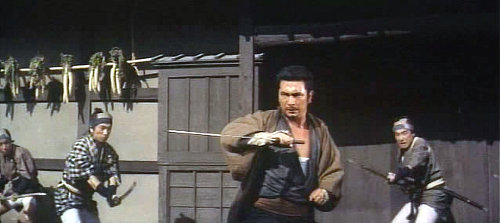
Zatoichi in his travels realizes that he
has come to a crossroad that is near the town of his old masseur Master and
the Master's daughter. Zatoichi has not been back for a decade and so decides
to visit, but upon arriving he discovers that his Master has been murdered
in an unsolved crime and that the daughter he knew as a child when they sang
together has been forced into a brothel where she is imprisoned till she
services customers. This is clearly an injustice that Zatoichi won't let
go by; that before all is said and done many will bleed.
This is a slower almost moody film with
only a few spurts of violence along the way - a Shane like young girl, a
Samurai with a need to challenge Zatoichi, the brutal treatment of the trafficked
brothel girls, the dice-thrower who repents all build a dramatic scenario.
Beautifully photographed starting with the rice ball in the middle of a lonely
road to the terrific street fight that ends the film.




